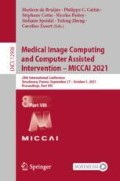Abstract
High-risk atypical breast lesions are a notoriously difficult dilemma for pathologists who diagnose breast biopsies in breast cancer screening programs. We reframe the computational diagnosis of atypical breast lesions as a problem of prototype recognition on the basis that pathologists mentally relate current histological patterns to previously encountered patterns during their routine diagnostic work. In an unsupervised manner, we investigate the relative importance of ductal (global) and intraductal patterns (local) in a set of pre-selected prototypical ducts in classifying atypical breast lesions. We conducted experiments to test this strategy on subgroups of breast lesions that are a major source of inter-observer variability; these are benign, columnar cell changes, epithelial atypia, and atypical ductal hyperplasia in order of increasing cancer risk. Our model is capable of providing clinically relevant explanations to its recommendations, thus it is intrinsically explainable, which is a major contribution of this work. Our experiments also show state-of-the-art performance in recall compared to the latest deep-learning based graph neural networks (GNNs).
Access this chapter
Tax calculation will be finalised at checkout
Purchases are for personal use only
References
Bien, J., Tibshirani, R.: Prototype selection for interpretable classification. Ann. Appl. Statist. 5, 2403–2424 (2011)
Chan, T.F., et al.: Active contours without edges. IEEE Trans. Image Process. 10(2), 266–277 (2001)
Chen, C., Li, O., Tao, D., Barnett, A., Rudin, C., Su, J.K.: This looks like that: deep learning for interpretable image recognition. In: Advances in Neural Information Processing Systems, pp. 8930–8941 (2019)
Elmore, J.G., et al.: Diagnostic concordance among pathologists interpreting breast biopsy specimens. JAMA 313(11), 1122–1132 (2015)
Hartmann, L.C., Degnim, A.C., Santen, R.J., Dupont, W.D., Ghosh, K.: Atypical hyperplasia of the breast–risk assessment and management options. New England J. Med. 372(1), 78–89 (2015)
Hase, P., Chen, C., Li, O., Rudin, C.: Interpretable image recognition with hierarchical prototypes. In: Proceedings of the AAAI Conference on Human Computation and Crowdsourcing, vol. 7, pp. 32–40 (2019)
Hugar, S.B., Bhargava, R., Dabbs, D.J., Davis, K.M., Zuley, M., Clark, B.Z.: Isolated flat epithelial atypia on core biopsy specimens is associated with a low risk of upgrade at excision. Am. J. Clin. Pathol. 151(5), 511–515 (2019)
Lakhani, S.R.: WHO Classification of Tumours of the Breast. International Agency for Research on Cancer (2012)
LeCun, Y.A., Bottou, L., Orr, G.B., Müller, K.-R.: Efficient BackProp. In: Montavon, G., Orr, G.B., Müller, K.-R. (eds.) Neural Networks: Tricks of the Trade. LNCS, vol. 7700, pp. 9–48. Springer, Heidelberg (2012). https://doi.org/10.1007/978-3-642-35289-8_3
Li, B., et al.: Classifying breast histopathology images with a ductal instance-oriented pipeline
Mehta, S., Lu, X., Weaver, D., Elmore, J.G., Hajishirzi, H., Shapiro, L.: Hatnet: an end-to-end holistic attention network for diagnosis of breast biopsy images. arXiv preprint arXiv:2007.13007 (2020)
Mercan, E., Mehta, S., Bartlett, J., Shapiro, L.G., Weaver, D.L., Elmore, J.G.: Assessment of machine learning of breast pathology structures for automated differentiation of breast cancer and high-risk proliferative lesions. JAMA Netw. Open 2(8), e198777–e198777 (2019)
Parvatikar, A., et al.: Modeling histological patterns for differential diagnosis of atypical breast lesions. In: Martel, A.L., et al. (eds.) MICCAI 2020. LNCS, vol. 12265, pp. 550–560. Springer, Cham (2020). https://doi.org/10.1007/978-3-030-59722-1_53
Pati, P., et al.: HACT-Net: a hierarchical cell-to-tissue graph neural network for histopathological image classification. In: Sudre, C.H., et al. (eds.) UNSURE/GRAIL -2020. LNCS, vol. 12443, pp. 208–219. Springer, Cham (2020). https://doi.org/10.1007/978-3-030-60365-6_20
Pedregosa, F., et al.: Scikit-learn: machine learning in Python. J. Mach. Learn. Res. 12, 2825–2830 (2011)
Quattoni, A., Torralba, A.: Recognizing indoor scenes. In: 2009 IEEE Conference on Computer Vision and Pattern Recognition, pp. 413–420. IEEE (2009)
Schnitt, S.J., Connolly, J.L.: Processing and evaluation of breast excision specimens: a clinically oriented approach. Am. J. Clin. Pathol. 98(1), 125–137 (1992)
Silverstein, M.: Where’s the outrage? J. Am. College Surgeons 208(1), 78–79 (2009)
American Cancer Society: Breast cancer facts & figures 2019–2020. Am. Cancer Soc. 1–44 (2019)
Tosun, A.B., et al.: Histological detection of high-risk benign breast lesions from whole slide images. In: Descoteaux, M., et al. (eds.) MICCAI 2017. LNCS, vol. 10434, pp. 144–152. Springer, Cham (2017). https://doi.org/10.1007/978-3-319-66185-8_17
Zhou, N., Fedorov, A., Fennessy, F., Kikinis, R., Gao, Y.: Large scale digital prostate pathology image analysis combining feature extraction and deep neural network. arXiv preprint arXiv:1705.02678 (2017)
Acknowledgments
The grant NIH-NCI U01CA204826 to SCC supported this work. The work of AP and OC was partially supported by the sub-contracts 9F-60178 and 9F-60287 from Argonne National Laboratory (ANL) to the University of Pittsburgh from the parent grant DE-AC02-06CH1135 titled, Co-Design of Advanced Artificial Intelligence Systems for Predicting Behavior of Complex Systems Using Multimodal Datasets, from the Department of Energy to ANL.
Author information
Authors and Affiliations
Corresponding author
Editor information
Editors and Affiliations
1 Electronic supplementary material
Below is the link to the electronic supplementary material.
Rights and permissions
Copyright information
© 2021 Springer Nature Switzerland AG
About this paper
Cite this paper
Parvatikar, A. et al. (2021). Prototypical Models for Classifying High-Risk Atypical Breast Lesions. In: de Bruijne, M., et al. Medical Image Computing and Computer Assisted Intervention – MICCAI 2021. MICCAI 2021. Lecture Notes in Computer Science(), vol 12908. Springer, Cham. https://doi.org/10.1007/978-3-030-87237-3_14
Download citation
DOI: https://doi.org/10.1007/978-3-030-87237-3_14
Published:
Publisher Name: Springer, Cham
Print ISBN: 978-3-030-87236-6
Online ISBN: 978-3-030-87237-3
eBook Packages: Computer ScienceComputer Science (R0)


